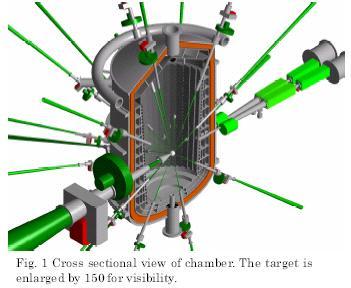PPCA.I-1
Concept of Laser Fusion Power Plant Based on Fast Ignition |
|
T. Norimatsu 1, Y. Kozaki 2, N. Miyanaga 1, J. Kawanaka 1, H. Azechi 1, H. Furukawa 3, and K. Tomabechi 4
|
1 Institute of Laser Engineering, Osaka University, Suita, Osaka 5650871 Japan.
2 National Institute for Fusion Science, Oroshi, Toki, Gifu, 5095292 Japan
3 Institute for Laser Technology, Nishi-ku, Osaka, 5500004, Japan.
4 Previous Advisor of Central Research Institute of Electric Power Industry |
Abstract:
This paper introduces new concept of laser fusion that is expected to demonstrate
energy generation based on inertial fusion in the near future. In the fast ignition (FI)
scheme, a spherical hollow solid deuterium-tritium fuel is compressed to a high density
of 1000 times solid density with tens nano-second laser pulses from a compression laser
and the compressed fuel core is directly heated to 5 keV with a ten pico-second laser
pulse from a heating laser. This FI scheme enables us to design an IFE power plant
with a 1MJ-class, compact laser whose output energy is 1/4 of previous central ignition
scheme. Recent progress on cooled Yb-YAG ceramic laser revealed that highly efficient
compression and heating lasers can be constructed using this laser material with
acceptable construction cost including laser diodes for pumping and the refrigerator.
New reactor scheme for a liquid wall reactor that has no stagnation point of ablated gas
and a rotary shutter system to protect the final optics are proposed.
Current computer simulation indicates thermonuclear gain of 160 will be achieved
with 1.1 MJ / 10 ns compression lasers and a 100 kJ / 10 ps heating laser. A
diode-pumped, cooled, Yb-YAG ceramic-laser is the prior candidate for the
compression laser operated at 16 Hz rep rate. The conversion efficiencies from
electricity to laser are 9.5% for the compression laser, 3.5% for the heating laser, and
6.9% in total including cooling power, respectively.
The power plant consists of 4 module reactors powered by one laser system. One
module reactor has 32 compression beams, one heating laser, and two target injectors as
shown in Fig. 1. Each beam port
has a rotary shutter and an electro
magnet to prevent the final optics
from neutral vapor and ions, respectively. The panels of the
first wall are tilted by 30 degree
to avoid stagnation of evaporated
vapor at the chamber center.
The focus position is vertically
off set to simplify the protection
mechanism of the ceiling.

|
|